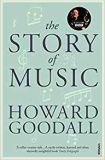The Story of Music by Howard Goodall
| The Story of Music by Howard Goodall | |
|
| |
| Category: Entertainment | |
| Reviewer: John Van der Kiste | |
| Summary: A tour through 40,000 years of music from prehistoric times to the present, published to accompany the author's BBC TV series of the same title | |
| Buy? Yes | Borrow? Yes |
| Pages: 359 | Date: January 2013 |
| Publisher: Vintage | |
| External links: Author's website | |
| ISBN: 9780701187521 | |
|
| |
As an award-winning composer of choral music, film and TV scores and stage musicals, Howard Goodall is well qualified to write and present on the subject. Covering something which has flourished for over 40,000 years in every shape and form imaginable is no easy task, but in this book, written and published to accompany a recent six-part documentary series on BBC2, he has distilled the lot into a very enlightening chronological narrative in just over 300 pages.
It all begins, he tells us in the first chapter, with the discovery of flutes made from animal and bird bones in caves in Slovenia and southern Germany. It is to these tiny precursors of the penny whistle that the massed woodwind of the Berlin Philharmonic Orchestra and Duke Ellington’s horn section could both trace their ancestry. It is not surprising to read that the Ancient Greeks, whose cultured dominated south-eastern Europe and the Near East for several centuries BC before their absorption into the Roman Empire, had a major impact on the development of music. They believed it to be a science and an art, and among their achievements were the invention of the organ and also the musical, in which dramas were accompanied by music and choral singing. The development of musical notation and tuning and the invention of other key instruments throughout what he calls ‘the age of discovery’, up to the mid-fifteenth century, are examined in detail.
With the age of the Renaissance came the advent of recognisable songs and carols, and to some extent the story of music became the stories of the great composers. John Dowland and Claudio Monteverdi are hailed as two of the greatest names of that era, although their fame was to be eclipsed by those who followed during ‘the age of invention’, broadly from 1650 to 1750. The achievements of Vivaldi, Bach and Handel tower above the rest, although it is ironic to consider that the two former were almost forgotten and little-performed for the first century or so after their deaths. It is also interesting to read that though Bach and Handel were born just eighty miles and four weeks apart, yet they never met. Opera composers, it is observed, have always attracted more immediate fame, or rather notoriety, than those of church music, and had Bach not confined himself to the latter, he might have been better-known at the time.
Indeed, great composers dominate the next two or three centuries. The late eighteenth century was dominated by Mozart and Haydn. The main difference between their styles, we are told, is a very simple one; if you can instantly remember the tune, it is one of Mozart’s. On the next page we are reminded that he was seen by those around him as a freakishly talented boy prodigy who forfeited his childhood to join the adult world too young – just like Michael Jackson two centuries later, in fact. He (Mozart, not Jackson) aimed to charm, seduce and occasionally tease his audiences with his music, while his immediate successor Beethoven’s mission was to confront them as an agent provocateur. Almost everything that happened in nineteenth-century music in some way, Goodall maintains, began with Beethoven.
The nineteenth century, it seems, virtually belonged to Germany – or perhaps their composers were merely larger than life. There was Wagner, there was Brahms, and there was Mahler. Yet other composers were making waves. At the same time, notably Verdi and Liszt, who with his merry-go-round of concert tours throughout Europe became the first international star. The term Lisztomania was not coined by film producer Ken Russell in the 1970s, but by reviewer Heinrich Heine in 1844, as he described female fans allegedly becoming ‘hysterical’ at the sight of him on stage.
From this time onwards, the story of music is a rich and varied one, and it is perhaps inevitable that Goodall’s prose becomes a trifle breathless in order to fit everything in. The advent of sound recording from the 1860s onwards helped to make music more accessible to all, particularly with the advent of the gramophone and then of radio broadcasting. ‘Non-popular’ music became generically known as ‘classical’ from the 1930s onwards, as a marketing tool by record companies eager to target consumers. Operetta, jazz and blues all competed for public affection, and Gershwin’s ‘Rhapsody in Blue’, when premiered at a concert in New York in 1924, a fusion of jazz and the classics, was one of those groundbreaking achievements which changed the world of music for ever.
The final chapter, which covers the years 1945 to 2012, features the music with which most present day audiences will be familiar. Who created rock’n’roll, you may ask? Several different ‘experts’ will give you several different answers, but according to Goodall, the credit should go to the Benny Goodman Sextet and their 1939 recording, ‘Seven Come Eleven’, featuring an electric guitar solo by the song’s co-writer, Charlie Christian. Ike Turner’s ‘Rocket 88’ of 1951 is usually regarded as the first rock’n’roll record, and soon after that the floodgates opened with Bill Haley, Elvis Presley and many others. In a crowded field, it is naturally impossible to discuss more than a handful of names, but the achievements of the Beatles, Bob Dylan and Stevie Wonder are rightly singled out. There are also mentions of the work of minimalist composer Philip Glass, and of Jon Lord, the classically-trained keyboard player and founding member of Deep Purple who later left the group to spend the rest of his days composing work in the classical idiom, among others.
Better-informed musicians than myself may well find grounds for criticism in this book. But this enthusiastic amateur enjoyed his rollercoaster ride through the last several hundred years. Mention should also be made of the playlists at the end, featuring several key works that accompany each chapter. It is highly recommended as a lively, admirably concise and obviously a very well-informed read.
If this book appeals then we can also recommend:
The Music Instinct: How Music Works and Why We Can't Do without it by Philip Ball
Musicophilia: Tales of Music and the Brain by Oliver Sacks
Please share on: ![]() Facebook,
Facebook, ![]() Twitter and
Twitter and
![]() Instagram
Instagram
![]() You can read more book reviews or buy The Story of Music by Howard Goodall at Amazon.co.uk Amazon currently charges £2.99 for standard delivery for orders under £20, over which delivery is free.
You can read more book reviews or buy The Story of Music by Howard Goodall at Amazon.co.uk Amazon currently charges £2.99 for standard delivery for orders under £20, over which delivery is free.
![]() You can read more book reviews or buy The Story of Music by Howard Goodall at Amazon.com.
You can read more book reviews or buy The Story of Music by Howard Goodall at Amazon.com.
Comments
Like to comment on this review?
Just send us an email and we'll put the best up on the site.


